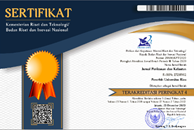Food Waste Potential as Alternative Feed Catfish Cultivation: an Overview
(1) Faculty of Agriculture, Universitas Warmadewa
(2) Faculty of Agriculture, Universitas Warmadewa
(3) Faculty of Agriculture, Universitas Warmadewa
(*) Corresponding Author
Abstract
Keywords
Full Text:
PDFReferences
[KKP] Kementerian Kelautan dan Perikanan. (2018). Refleksi 2018 dan Outlook 2019.
Anggraeni, D.N., & Rahmiati. (2016). Pemanfaatan Ampas Tahu Sebagai Pakan Ikan Lele (clarias batracus) organic. Biogenesis Jurnal Ilmiah Biologi, 4(1):53-57.
Anis, M.Y., & Hariani, D. (2019). Pemberian Pakan Komersial dengan Penambahan EM4 (Efektif Microorganisme) untuk Meningkatkan Laju Pertumbuhan lele (Clarias sp). Jurnal Riset Biologi dan Aplikasinya. 1(1)
Junaida, I.S. (2017). Tingkat Konsumsi Ikan di Indonesia: Ironi di Negeri Bahari. Jurnal Penyuluhan Perikanan dan Kelautan, 11(1):12-24.
Muntafiah, I. (2020). Analisis Pakan pada Budidaya Ikan Lele (Clarias sp) di Mranggen. Jurnal Riset Sains dan Teknologi, 4(1): 35-39.
Selopes, M., Indrawati, E., Mulyani, S., Budi, S. (2020). Analisis Efektifitas Fermentasi Limbah Perut Ikan Terhadap Pertumbuhan dan Sintasan Ikan Lele Clarias sp. J. of Aquac. Environment, 3(1): 1-5.
Wardani, R.E., Prayogo, M., & Agustono, M.K. (2017). Potensi Penambahan Azolla sp. dalam Formulasi Pakan Pembedahan. Journal of Aquaculture and Fish Health, 6(2)
Widagdo, A.B., Elfitasari, T., & Basuki, F. (2016). Strategi Pengembangan Budidaya Pembesaran Ikan Lele (Clarias sp) di Kecamatan Gunung Pati Kota Semarang. Prosiding Seminar Nasional Tahunan ke –V Hasil-Hasil Penelitian Perikanan dan Kelautan (Juni):199-211
Windriani, U. (2017). Budidaya Ikan Lele Sistem Bioflok. Direktorat Produksi dan Usaha Budidaya.
Yanuar, A., Tyasari, F.G., & Dughita, P.A. (2018). Pemanfaatan Limbah Organik dari Rumah Makan Sebagai Alternatif Pakan Ternak Ikan Budidaya. AGRONOMIKA, 13(1).
Yunaidi., Rahmanta, A.P., & Wibowo, A. (2019). Aplikasi pakan pelet buatan untuk peningkatan produktivitas budidaya ikan air tawar di desa Jerukagung Srumbung Magelang. Jurnal Pemberdayaan, 3(1)
Article Metrics
Abstract view : 179 timesPDF - 283 times
DOI: http://dx.doi.org/10.31258/jpk.28.1.97-102
Copyright (c) 2023 Gede Agus Surya Pratama, Sang Ayu Made Putri Suryani, I Nengah Muliarta

This work is licensed under a Creative Commons Attribution-NonCommercial-NoDerivatives 4.0 International License.
Gedung Marine Center Lt 2. Fakultas Perikanan dan Kelautan Universitas Riau



